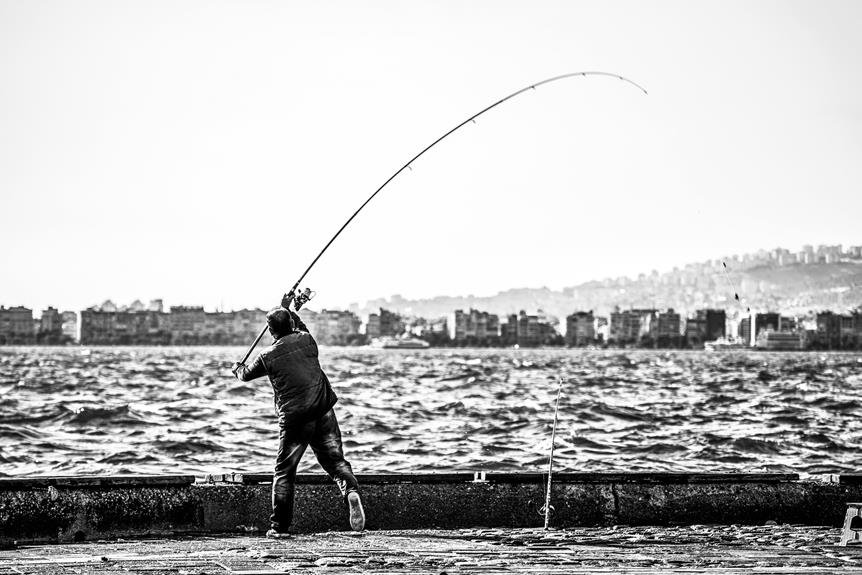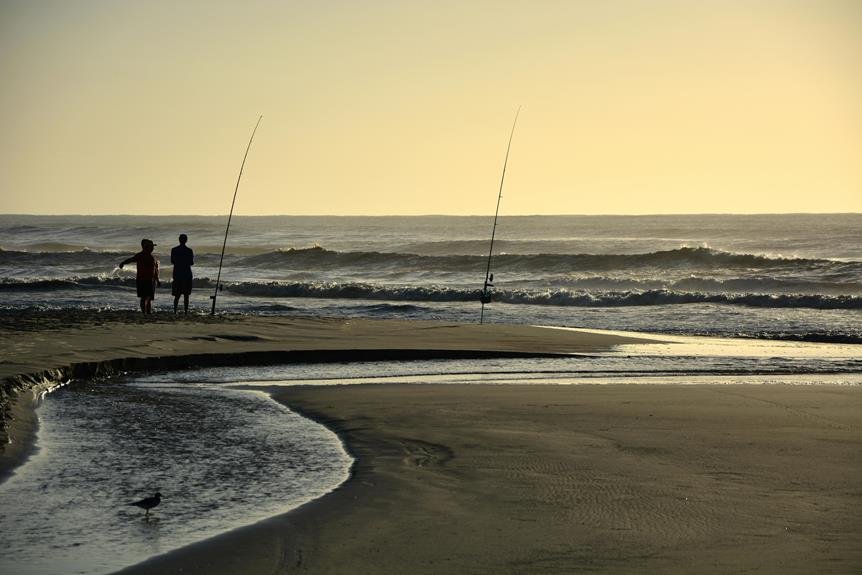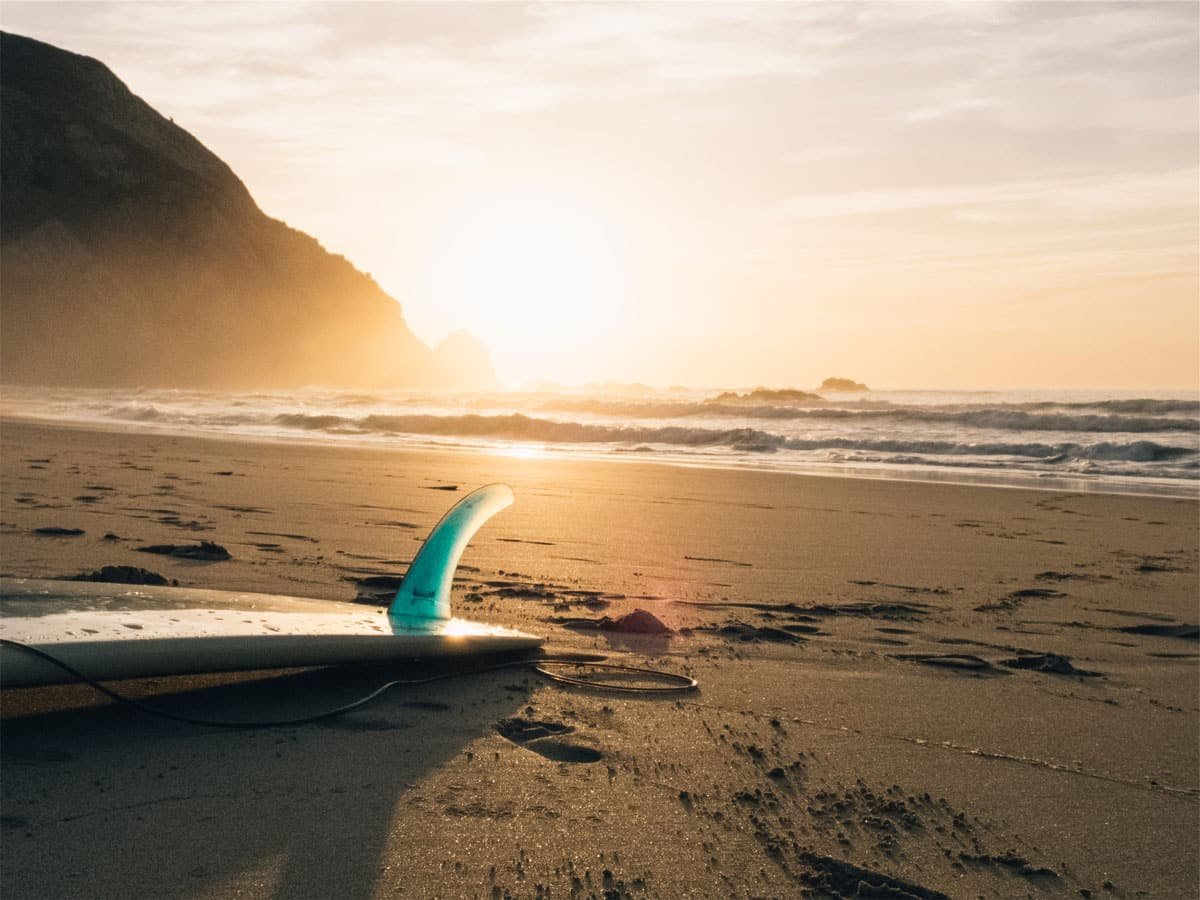You're about to catch more fish than you ever thought possible with the right surf fishing strategy. Start by checking state fishing regulations and planning ahead with research on the target species, habitats, and Moon phases. Prepare your gear and tackle, selecting a rod and reel combo designed for surf fishing and suitable for the target species. Understand the importance of timing, focusing on peak tidal movements and adjusting to changing weather and tide conditions. Mastering these basics will get you started, but there's more to uncover to take your surf fishing skills to the next level.
Key Takeaways
- Research the target species and their habitats to refine techniques and improve catch rates.
- Plan surf fishing trips during peak tidal movements when fish are more active.
- Choose gear that can withstand the harsh saltwater environment and tailor lures to the target species' preferences.
- Fish are more active during rising and falling tides, making these times ideal for surf fishing.
- Adjust to changing weather and tide conditions to maximize catch rates.
Pre-Fishing Preparations
Before you hit the beach, make sure to check state fishing regulations, as some states require a fishing license when fishing from the shoreline or from a fishing pier. To guarantee a successful surf fishing trip, plan ahead and prepare. Start by checking the weather forecast to secure favorable fishing conditions. Keep a fishing journal to track your progress, note the best times and locations, and identify patterns. This will help you refine your techniques and improve your catch rate. Additionally, make sure you have all the necessary gear and tackle before heading out. By doing your due diligence, you'll be well-prepared for a productive and enjoyable surf fishing experience.
Choosing the Right Gear
When it comes to choosing the right gear for surf fishing, you'll want to select a rod and reel combo that's specifically designed to handle the power and strength of fish in the surf zone. Think about the type of fishing rod and reel combo needed for your target species. A medium-heavy fishing rod is suitable for smaller species, while a longer, heavier rod is better for larger species. Don't forget about gear maintenance – regularly check and clean your gear to guarantee it's in top condition. You may also want to ponder rod customization, such as adding a longer butt section or a heavier guide, to improve your casting distance and accuracy. By choosing the right gear and taking care of it, you'll be well on your way to a successful surf fishing trip.
Selecting Effective Tackle
You'll want to stock your tackle box with a variety of rigs and lures that cater to the feeding habits and habitats of your target species, as the right tackle can make all the difference in your surf fishing success. When selecting tackle, consider the Tackle Materials that will withstand the harsh saltwater environment. Choose lures made from durable materials like stainless steel, titanium, or high-quality plastics. Lure Customization is also essential, as it allows you to tailor your lures to your target species' preferences. For example, use bright colors for species like striped bass and more natural colors for species like flounder. By having a well-stocked tackle box with customized lures, you'll be better equipped to catch your target species. Remember, the right tackle can make all the difference in your surf fishing success.
Timing Is Everything
During peak tidal movements, fish tend to be more active, making these times ideal for surf fishing. As you plan your surf fishing trip, make sure to check the tide charts and surf forecasts to maximize your catch. Here are some timing tips to keep in mind:
- Rising and falling tides: Fish are more active during these times, so try to plan your trip accordingly.
- Early morning and late afternoon: These are usually the best times to fish during the hottest months.
- Days before a cold front: Take advantage of the prime fishing conditions before the front arrives.
- Adjust to changing weather and tide conditions: Be prepared to adapt your fishing schedule as the weather and tides change.
Best Surf Fishing Spots
Identify your target species and research the best surf fishing spots where they're commonly found, as different species tend to congregate in specific areas. For example, striped bass often hang around coastal structures like piers, jetties, and breakwalls, while species like pompano and whiting prefer the sandy beach areas. Look for beach features like sandbars, troughs, and sloughs, as these can be hotspots for species like redfish and trout. Researching the best surf fishing spots beforehand will increase your chances of catching your target species. Don't be afraid to explore and try out new spots, as the best fishing spots can change with the seasons and tides.
Fishing License Requirements
Before you hit the beach, make sure you're aware of the fishing license requirements for the state and location you're surfing in, as regulations can vary substantially from one region to another.
Check the specific state laws and local regulations where you plan to surf fish. Some key things to examine:
- Resident vs. Non-Resident Licenses: Determine if you need a resident or non-resident license, as fees and requirements differ.
- License Types: Check if you need a saltwater or freshwater license, or a combination of both.
- Age and Disability Requirements: Some states offer free or discounted licenses for seniors, disabled individuals, or veterans.
- Permits and Stamps: Find out if you need additional permits or stamps for specific species, like sharks or striped bass.
Safety First Measures
When venturing into the surf, prioritize your safety by wearing a properly fitted life jacket and staying alert to the ocean's conditions. Be aware of strong currents, rip tides, and sharp rocks that can cause injuries. Take wading precautions by wearing chest waders and an elastic wading belt to prevent water from flowing inside in case of a fall. Don't forget sunscreen protection to shield your skin from the harsh sun. Apply a broad-spectrum sunscreen with a high SPF and reapply regularly. Stay hydrated by bringing plenty of water and taking breaks in shaded areas. By taking these safety measures, you'll be able to focus on catching fish while staying safe and healthy.
Bait Selection Strategies
As you prepare to surf fish, selecting the right bait is essential, and experimenting with different natural baits like squid, shrimp, or mullet can help you determine which ones work best for your target species. When it comes to bait selection, you've got several options to explore.
- Fresh Baits: Use fresh, high-quality baits like squid, shrimp, or mullet to increase your chances of catching fish.
- Live Lures: Live lures like minnows, crabs, or small fish can be very effective for species like striped bass and bluefish.
- Cut Baits: Cut baits like cut squid, fish guts, or shrimp can be used to target species like sharks and rays.
- Artificial Lures: Artificial lures like spoons, plugs, or jigs can be used to target species like bluefish and striped bass.
Rod and Reel Combo
Choose a rod and reel combo that's tailored to your target species, considering factors like rod length, action, and reel capacity to guarantee you're well-equipped to land your catch. For instance, if you're targeting smaller species like spotted seatrout or bluefish, a 7-9 foot medium-heavy fishing rod will do the trick. However, if you're after larger species like striped bass or sharks, you'll need a longer, heavier rod with a reel that can handle up to 8 ounces of weight. Don't be afraid to customize your rod to fit your fishing technique. Consider adjusting the action, guides, and reel seat to optimize your casting distance and accuracy. By selecting the right rod and reel combo, you'll be able to execute your fishing technique with precision and confidence, increasing your chances of landing a trophy catch.
Fishing During Tides
You'll want to time your surf fishing trips according to the tides, as the changing water levels and currents can greatly impact your catch rate. Understanding tidal patterns and how they relate to Moon phases is essential for success. Here are some key considerations:
- Rising tide: Fish tend to move closer to shore as the tide rises, making it an ideal time to target species like striped bass and bluefish.
- Peak tide: Fish often congregate in areas with structural features, such as sandbars or rock piles, during peak tide.
- Falling tide: As the tide drops, fish may move into deeper waters, making it a good time to target species like flounder and pompano.
- Moon phase: Pay attention to the full and new Moon phases, as these can trigger feeding frenzies in certain species.
Reading the Water Conditions
When you're surf fishing, being able to read the water conditions is essential, as it helps you identify potential hotspots and increases your chances of catching fish. You need to pay attention to water clarity, as clear water usually indicates a lack of nutrients, making it less likely to find fish. On the other hand, murky or cloudy water can be a sign of baitfish activity, attracting predators. Ocean currents also play a vital role, as they can create areas of turbulence that attract fish. Look for areas where currents converge or where there are changes in water depth or structure. These areas often become hotspots for fish. By reading the water conditions correctly, you can increase your chances of catching fish and having a successful surf fishing trip.
Frequently Asked Questions
Can I Surf Fish at Night With a Headlamp or Flashlight?
You can surf fish at night with a headlamp or flashlight, but prioritize beach safety and night vision by wearing reflective gear, using a red light to preserve your vision, and being mindful of your surroundings.
Do I Need to Remove the Hook From a Fish's Mouth Carefully?
"Practice makes perfect," and when it comes to hook removal, you'll want to master this skill. When handling fish, gently grasp the fish's mouth, carefully twist and remove the hook, taking care not to cause internal damage.
Can I Surf Fish With a Friend or Do I Need to Go Solo?
You can definitely surf fish with a friend, and it's often more fun with a buddy! Just be sure to coordinate your gear, like sharing rods and reels, and take turns casting to avoid tangles and increase your catch.
Are There Specific Surf Fishing Techniques for Beginners?
As you wade into the ocean, it's like stepping into a vast, unpredictable library – you need to know which 'books' to read. For beginners, understanding tide knowledge is key, and selecting the right line is essential; start with a medium-weight line and adjust as needed.
Can I Eat the Fish I Catch While Surf Fishing Immediately?
You can enjoy your fresh catch immediately, but prioritize food safety: clean and gut the fish promptly, store it on ice, and consider cooking methods like grilling, baking, or frying to savor your prize.
Conclusion
You've made it to the final cast! With these surf fishing tips, you're armed to conquer the coastline. Remember, every wave, every tide, and every bait choice is a calculated move in the game of landing the ultimate catch. You're not just fishing, you're outsmarting the ocean itself. So, go forth, brave the surf, and reel in the adventure of a lifetime – because with these secrets, the possibilities are endless, and the fish are waiting!









